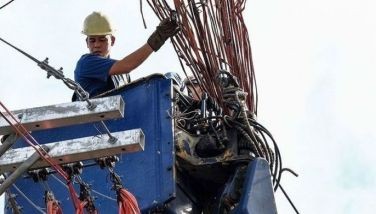Transco warns of possible power crisis in Mindanao
July 26, 2004 | 12:00am
The National Transmission Corp. (Transco) has warned that the delay in the Leyte-Mindanao Interconnection Project (LMIP) could bring power crisis in Mindanao in the medium-term.
Transco president Alan T. Ortiz revealed that the economic managers led by the National Economic and Development Authority have scratched the LMIP in Transco’s capital expenditure program.
"The LMIP is not part of our capex program. The economic managers believed that it should be left to the concessionaire (who will take over the Transco assets)," Ortiz said.
Ortiz said there is still no assurance that the concessionaire would undertake such project and this may lead to power problem in the province.
"A number of power plants would be built in Mindanao like the 200 megawatt (MW) coal-fired power plant of Korea Electric Power Co. and new baseload power plant of Mirant Corp. The transmission line there would not be enough to accommodate these new loads," he said.
But Ortiz said they are still trying to convince the NEDA to reconsider its decision. "We are trying to justify it to the economic managers. They are not fully convinced (on the importance of the project to the entire Philippine grid)," he said. "We are convincing them that putting more baseload power plants in the province is far more expensive than putting up more submarine cable. Besides, it also takes a lot of time to build these merchant plants," he said.
The Transco chief also pointed out that the LMIP would also help make the Wholesale Electricity Spot Market (WESM) work efficiently. WESM provides the trading of electricity on an hourly basis. Without efficient transmission lines, the main purpose of WESM to provide efficient, reliable and cheaper power would be defeated.
Ortiz said financing the project would not also be a problem since a number of Japanese companies have expressed interest to undertake the project including the upgrading of the feasibility study for LMIP.
"There is a high level of interest from various Japanese companies to participate in the bidding," Ortiz said.
Transco has been proposing for the acceleration of the implementation of the LMIP to 2008 from earlier scheduled 2011 to help resolve the imminent power shortage in Mindanao region.
"It should start by 2004 so that it can be completed in 2008 from the original 2011 schedule. We hope it can be included in the 2005 Transmission Development Plan," Ortiz said. It was expected that Mindanao will be experiencing power shortage in 2005 unless the government do something about it.
In 2002, the government decided to defer the implementation of the P18 billion interconnection project due to some financial constraints.
The LMIP was supposed to be included in the list of projects that the Asian Development Bank (ADB) will finance for 2003. But the multilateral financial institution reportedly canceled the project from its list after the government raised its intention to defer it.
Since the privatization of Transco is already in the offing, the government opted to defer the project to allow the winning concessionaire to carry out the project.
The LMIP was supposed to be the final phase in the unification of Luzon, Visayas and Mindanao grids. It will enable the deferment of additional baseload plants in the region and lower the system production cost as a result of the overall pooling of resources.
The interconnection project is designed for 250 kilovolt high-voltage density cable bipolar link with a total transfer capacity of 500 MW.
The project includes 455 kilometers long overhead line and 23 km submarine cable with a maximum depth of around 1,000 meters below sea level.
It emanates from the existing Ormoc Converter Station in Leyte and terminates at Kirahon Converter station in Northcentral Mindanao via Southern Leyte and Northeastern Mindanao.
Transco president Alan T. Ortiz revealed that the economic managers led by the National Economic and Development Authority have scratched the LMIP in Transco’s capital expenditure program.
"The LMIP is not part of our capex program. The economic managers believed that it should be left to the concessionaire (who will take over the Transco assets)," Ortiz said.
Ortiz said there is still no assurance that the concessionaire would undertake such project and this may lead to power problem in the province.
"A number of power plants would be built in Mindanao like the 200 megawatt (MW) coal-fired power plant of Korea Electric Power Co. and new baseload power plant of Mirant Corp. The transmission line there would not be enough to accommodate these new loads," he said.
But Ortiz said they are still trying to convince the NEDA to reconsider its decision. "We are trying to justify it to the economic managers. They are not fully convinced (on the importance of the project to the entire Philippine grid)," he said. "We are convincing them that putting more baseload power plants in the province is far more expensive than putting up more submarine cable. Besides, it also takes a lot of time to build these merchant plants," he said.
The Transco chief also pointed out that the LMIP would also help make the Wholesale Electricity Spot Market (WESM) work efficiently. WESM provides the trading of electricity on an hourly basis. Without efficient transmission lines, the main purpose of WESM to provide efficient, reliable and cheaper power would be defeated.
Ortiz said financing the project would not also be a problem since a number of Japanese companies have expressed interest to undertake the project including the upgrading of the feasibility study for LMIP.
"There is a high level of interest from various Japanese companies to participate in the bidding," Ortiz said.
Transco has been proposing for the acceleration of the implementation of the LMIP to 2008 from earlier scheduled 2011 to help resolve the imminent power shortage in Mindanao region.
"It should start by 2004 so that it can be completed in 2008 from the original 2011 schedule. We hope it can be included in the 2005 Transmission Development Plan," Ortiz said. It was expected that Mindanao will be experiencing power shortage in 2005 unless the government do something about it.
In 2002, the government decided to defer the implementation of the P18 billion interconnection project due to some financial constraints.
The LMIP was supposed to be included in the list of projects that the Asian Development Bank (ADB) will finance for 2003. But the multilateral financial institution reportedly canceled the project from its list after the government raised its intention to defer it.
Since the privatization of Transco is already in the offing, the government opted to defer the project to allow the winning concessionaire to carry out the project.
The LMIP was supposed to be the final phase in the unification of Luzon, Visayas and Mindanao grids. It will enable the deferment of additional baseload plants in the region and lower the system production cost as a result of the overall pooling of resources.
The interconnection project is designed for 250 kilovolt high-voltage density cable bipolar link with a total transfer capacity of 500 MW.
The project includes 455 kilometers long overhead line and 23 km submarine cable with a maximum depth of around 1,000 meters below sea level.
It emanates from the existing Ormoc Converter Station in Leyte and terminates at Kirahon Converter station in Northcentral Mindanao via Southern Leyte and Northeastern Mindanao.
BrandSpace Articles
<
>
- Latest
- Trending
Trending
Latest
Trending
Latest
Recommended

























